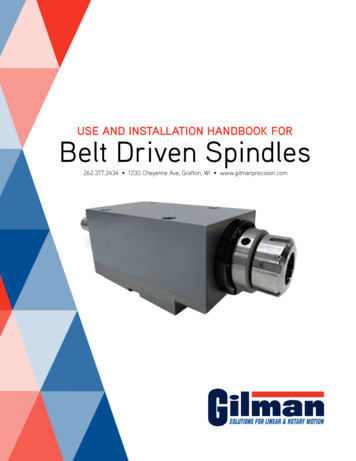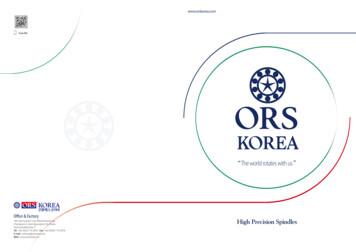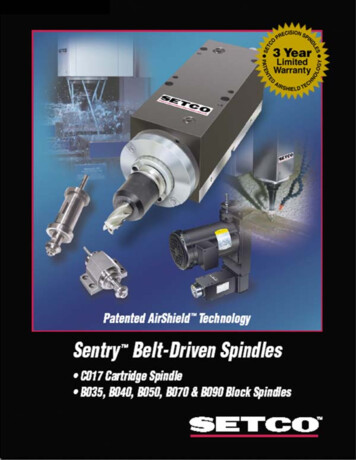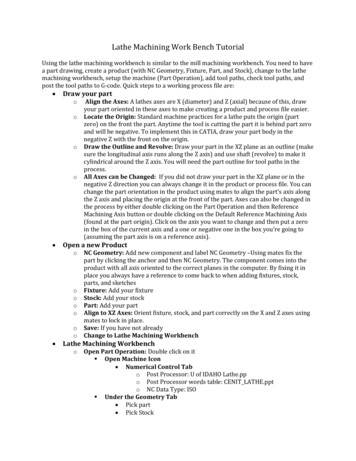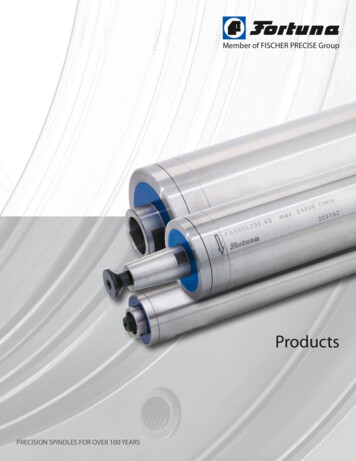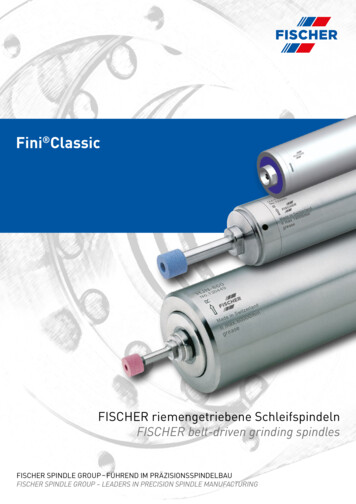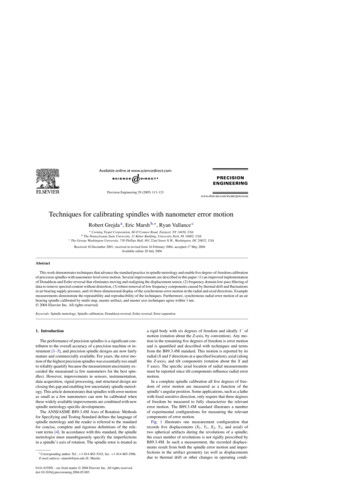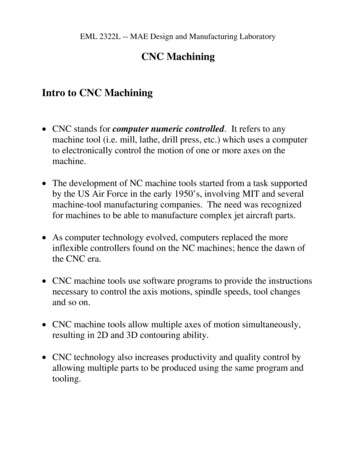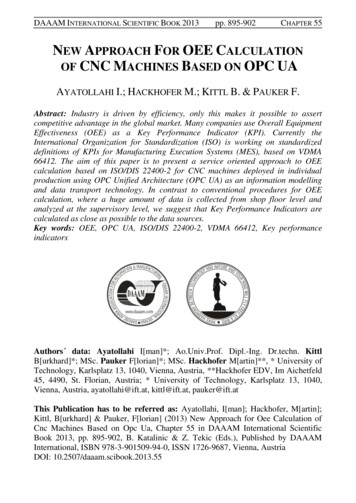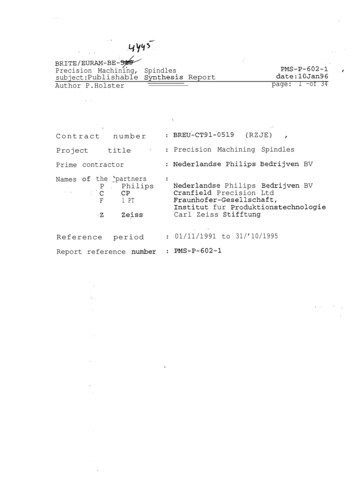
Transcription
,!.,.,,,),4y’@-,,,,’BRITE/EURAM-BE- ‘% Precision Machining, Spindlessubject:Publishable S@thesis ReportAuthor P.Holster,’.,PMS-P-602-1date:10Jan96page: 1 -of 34,,.‘,\ContractProject.,title Prime contractorW./’Names,.the ‘partnersP ,- PhilipsCP:-c1 PTFz:(RZJE) ,/Precision Machining Spindles:Nederlandse ,Philips Bedrijve BV:numberBREU’--CT9”051919:Nederlandse Philips ,Bedrijven BVCranfield Precision LtdFraunhofer-Gesellschaft,Institut fur ProduktionstechnologieCarl Zeiss StifftungZeiss,,ReferenceperiodReport reference .nuinber:01/11/1991 to 31/’10/1995:PMS-P-602-1,.,.
BRITE/EuMwl-BE-519Precision’ Machining, Spindlessubject: Publishable Synthesis ReportAuthor P.HolsterPMS-P-602-1date:10Jan96page: 2 of 34Table of ContentsABSTFUiCT . . . . ,.,.,3. . . . . . . . . . . . . . . . . . . .Precision Machining Spindles . . . . . . . . . . . . . . .1; History before the project started .; . . ., . . . . . .,2. Introduction . . . . . . . . . . .4. . . . . . . . .3. preliminary study . .’ . ,. . . :, . . . . . . . . . . .3.1 High speed spindle specifications . . . . . . . . .3.2 Program rotor-bearing dynamics . . . . . . . . . . . .3.,3 Hybrid,bearing calculation . . .’ . . ., . . . . . . ‘.3.4 Compare bearings, choose spindle . . . . . . . . . . .3.5 Design optimization.tool . . . . . . . . . . . . . . .4. Prototype HSS design. . . . . . . . . . . . . . . . i . .“ .4.1 Design rotor and bearings. . . ,. . . ,. .,.” ““” .4.2 Design machine mount . . . . . . . . . . . . . . . . .4.3 Design integrated cooling . . . . . . . . . ., . . . .5. prototype spindle analysis . . . . . . . . . . . . . . .5.1 Dynamic rotor/bearing analysis . . . . ‘a ., . . . . .,5.2 StaticF E-analysis . . . . . . . . “. . . . . . . . .“5.,3’ Thermal analysis . .’ . . ,. . . . . . .:. . . . .6. Prototype manufacturing ., . . . . . . . . . . . . . . . .6ilDrawing . . . . . . . . . . . . . . . . . . . . .6.2 Manufacture, assembly and balancing . . . . . . . . . . . . . . . .7. prototype high speed spindle tests . . . ,,. . . . . . .8. The second prototype . . . . . . . . .“.8.1 Prototype breakdown analysis . . . . . . .’.8.2 Design changes “. . . . . . . . . . .9. Second prototype spindle measurements . . . . . . . .9.1’ Grinding experiments . . . . . . . . . . . . . . . .9.1.1 Grinding experiments (CPE) . . . . . . . . . . .9.1.2 Grin,ding ’experiments ,(Zeiss) . . . . . . . . . .9.1.3 Grinding experiments (Philips) . . . . . . . . .9.1.3 Analysis of grinding results . . . . . . .’ . . . .9.2 Thermal measurements (IPT) . . . . . . . . . . . . . . .9.3 Dyhamic stiffness measurements (IPT) . . . . . . . .9.4 Error’ motion measurements (CPE). ., . . . . . . . . .,10. Final spindle redesign . . . . . . . . . . . . . . . .10.l Design changes . . . . . . . . . . . . . . . . . .10.2 Analysis of the redesigned spindle . . . . . . . .10.3 Manufacturing . . . . . . . . . . . . . . . . . . .1“1. Optimized design tests . . . . . . . . . . . . . . .11.1 Measure thermal behav,iour . . . . . . . . . . . . . . . . . . . .11.2 Grinding tests . . . . . . . . . . . . . . . .11.3 Measure error motions . . . . . . . . . . . . .11.4 Measure dynamic behaviour, . . . . . . . . . . .12. Conclusions . . . . . . . . . . . . .References . . . . . . . . . . . . . . . .445556667“8;8‘X8“e8’9 ’910“1011111112”121 213141141515*1 616161718.181 91922020202121,22
,.,. .,,,, LBRITE/EuRAM-BE-519” Precision Machining ’Spindles”subject: Publishable ��Jan96page: 3 of 34 ‘,,Report,,\,.,,“,.ABSTRACTThis report de”sgribes the, BRITE/EURAM project BE-519, Precisionmachining spindles. The main purpose of “our project was todevelop a High Speed Spindle with properties beyond the ones ofcommercially, available spindles, to be able to produce betterarindinqre ults.Philips (Eindhoven). was the prime contractor%d the-other partners were IPT Fraunliofer (’Aachen), Cranfield.precision and Carl Zeiss (Oberkochen) . For the, second half of the’/. project Hembrug was the End User (chapters 1 and 2) . “,we started with an ambitious list of specifications beyond the!. /ones of c’ommercial’ly available spindles:i. That illustrates thatd-,1all partners were more end users than. spindle manufacturers. Theproject was guided by the strong believe that analysis (physicalunderstanding plus calculation power) is needed to realise the ‘.spindlewewereaimingat(chapter3). Analysis and design were performed in parallel so both effectedeach other in,good cooperation (chapters” 4 and 5) .This report gives five cross sections of spindle designs at different stages in the project showing the evaluation into’ aspindle that can be manufactured and used for actualhigh quality\grinding.The third design was actually manufactured as first prototype andalready reached the 100,000 rpm (chapter 6’ and7) . That protot ecrashed at 104,000 rpm after only three weeks of operation. Aftera breakdoti. analysis we found extra”power losses neglected in thefirst analysis (chapter 8) . New calculations plus ‘some designimprovements were the basis for the second prototype that wasmanufactured. That second prototype’ went on a tour’ along all partners and was tested extensively during a one years periodchapter 9) .Meanwhile the design work concentrated on manufacturing ”costsreduction and user friendliness. From ‘that design four spindleswere manufactured, one for each partner (chapter 10) .Preliminary tests of this redesigned spindle are reported inc h a p t e r 1 1,.,.,\.,,.,,
,BRITE/Eum.M-BE-519Precision Machining Spindlessubject: Publishable Synthesis Report ‘AuthorP.Holster ,.PMS-P-602-1date:10Jan96page: 4 of 34Precision Machining Spindles1. Historv before the roiect startedThe need for a precision, machining spindle as developed in”thisproject became evident’at Philips during measurements of grinding‘forces in February 1987. That work is part of a thesis from DrJ. Franse (reference 11). From his error budget (table I ) itcanbe found that his. grinding spindle compliance” was the largest .;errqr source giving more than 70% of the total error.ErrorsourceError [rim]3.3’;,1.20z–slide3 . 81.38motionsHeadstock run-out20.,07.29Reference ,mirror0.50.180.5’0.18,,“0.4.Laser resolution1 0 . 0Thermal30:0’errorsLaser errors (refr. index)6.Grinding spindle compliance ‘2 0 0 . .Total’ (worst case) error EtOt274.5b,.% of E otx–slide motions ,Sl”ide compliancies.Headstock compliance, ., 0.153.6410.9’32.1972.86 “’100.kTable I. Form error budget of ESDO for a 5’ m“ ground mould‘At November 04 1987 Philips Engineering department started todevelop a high stiffness/high speed spindle according to theirstate of the art.Philips and IPT started’ cooperation on precision machining inMarch 1988, and in May 1988 they choose a high speed grinding ‘spindle as carrier for that cooperation. When CPE and Zeiss alsodid show interest in.this subject we started the preparation ofa BRITE/EURAM proposal January 1989. That BRITE’ proposal datedAugust 17 1989 was rejected in January 1990. An adapted proposal(ref number 4445) went through a negotiation meeting in Brussels(February 13 1991). The work programme was adapted into versiondated June 12 1991 and the proposal was granted to start November01 1991 (in stead of July 01 1991) for a 3.5 years period.
,’,,,.‘.;.,’BRITE/EuRAM-BE-519Precision Machining Spindles’subject: Publishable SynthesisAuthorP.Holster,-, ’.,,PMS-P-602-1dat,e:’10Jan96,page: 5 of’34Report.Acontract BREU-CT91-0519 (RZJE) w“as signed between:The European Economic Community (Brussels Belgium)andNederlandse P’hilips Bedrijven BV (Eindhoven The Netherlands)Cranfield Precision Engineering LTD (Cranfield England)Fra,unhofer-Gesellschaft (Aa,chen Germany)Carl Zeiss Stifftung (Oberko.then Germany)with Hanseatische Praezision und Orbittechnik GmbH as End userWe asked for extension of the contract and the ,EEC agreed August30 1994. So the duration of the project became 48 months fromNovember” 1’1991 ending at 31 October 1995. IWhen HPO ceased. trading around mid term of’ the”project, ductionThe’ main purpose of our project was to develop ,a High SpeeSpindle (HSS)’ with properties beyond the ones o’f commerciallyavailable. spindles to be able to produce better grinding resultsThe logical sequenceof our project in work packages is first aPreliminary study, then the HSS e,sign, thereafter the HSS’manufacturing and HSS tests including grinding experiments. Asimplified planning, of:the whole project .is given in figure 2.After testing the prototype, another cycle from design to testingwas planned to obtain optimized spindles.The spindle specifications we aimed for were’ that high that we‘could only reach them with narrow bearing gaps: As” a consequence,the manufacturing costs of a prototype HSS spindle were. far morethan planned. That made us to concentrate on manufacturing costs.,reduction in the optimization stage.The ’prototype spindle did run 100,000 rpmbut eras’hed before wecould perform -all measurements and grinding experiments. Thebreakdowm analysis showed that the estimated spindle losses-werfar more than predicted and the reason for this was determined.As a consequence a second prototype, is manufactured based ‘on newcalculations. That second prototype performed “well in themeasurements. However that was at the .expense of half a yearextension “. of the project duration. Finally four redesignedspindles were manufactured, one for each partner. Those sp”indlesare” designed for actual use in production3. PreliminaryStudv,,13.1 High speed spindle;specifications,The high speed spindle specifications ‘were . consolidated, seefigure 3.1. The. most appealing ones were:,!maximum rotating speed . . . . .1 . . . . . . . . ,100,0OOrpml.,,radial stiffness at cutting edge . . . . 20 N/pmaxial ‘stiffness at cutting edge . . . . . 20 N/pm ,radial synchronous error motion . . . . . 50 nm :radial asynchronous error motion . . . . 20 nmthermal drift (’after 10 minutes) .’. .:10 “Mi ’ ,.,
BRITE/EumM-BE-519Precision Machining Spindlessubject: Publishable Synthesis ReportAuthor P.HolsterPMS.-P-6O2-1“date:10Jan96page : 6 Of 34We did realize that some goals were rather ambitious; so we”included a list o,f ‘HSS decision criterions illustrating theweight each partner gave to each subject.3-.2 Progr,arn rotor-bearing dynamicsFor the calculation of rotor-bearing dynamics we used the Philips ,.program RODY. The design is divided into elements like shafts,disks and,the bearings are represented by springs and damperThe element properties including gyroscopy are assembled and the“solution is found using PC–Matlab as a tool.For compressible fluid bearings the original Philip’s program RODYis extended in cooperation with Technical University of .Eindhoven(references 2], 3] and 4]) into RODY4, capable tohandle: compressible bearing coefficients (depending ,not only uponrotational speed but also upon excitation frequency) . .ib.,3.3 Hybrid bearing calculationWe generated our own bearing coefficients because literature doesnot provide the numbers we need. At.a very late state we decidedthat externally pressurized spiral groove bearings were favouredover orifice type bearings.Starting from existing FEM programs, one, for calculating staticbehaviour’of spiral groove bearings with.compressible lubricantsand one for calculating dynamic coefficients of externally .,pressurized bearings; Philips is, capabl-enow to supply the data :needed for the dynamic RODY analysis.For the thrust bearing we extended existing’ computer code withdynamic elements” to calculate stiffness (and damping) o-fexternally pressurized spiral groove compressible bearings.Unexpectedly we found that such thrust bearings become unstableabove a certain critical speed. Higher supply pressures have astabilizing effect.The progrfis were also adapted to calculate partially tapered Jgaps to enable us to predict the bearing properties with axiaQbearing ’clearances variations.,3.4 Compare bearings, choose spindle configuration At our kick-off meeting we made a choice of four different :designs out of nine proposals for further evaluation. Out of thatevaluation we choose the,conventional design w .than integratedmotor drive located between the journal bearings and with aconical froht bearing that combined. axial and radial support (seefigure 3.2). We choose for an integrated motor in between thebearings because we have no better ideas than existing designsthat cannot guarantee precision at hi’gh speeds.The choice for spiral groove bearings over orifice bearings ismade because of design considerations. (no separate radial supplychannels to each restrictor needed) . One should realize that injournal bearings the spiral grooves make the bearing stable inconcentric operation. Smooth journal bearings have a larger loadcarrying capacity but are not stable until the ,eccentricity ismore than about half the gap height. The external pressurizationis primarily intended for contactless starting up and stopping
,.,BRITE/EuRAM-BE-519Precision Machining Spindlesssubject: Publishable Synthesi ReportAuthorP.Holster ;PMS-P-602-1date:10Jan96page’: 7 of 34(no wear) but also results. in higher stiffness and et!er ‘‘ stability (because the ‘air behaves,, more lncomPre,s.Slble) “Pressurization of spiral groove bearings also constitutes a,spira groove.mo.tor, in’ our case the spindle runs at about 5,000rpm without’motor drive and has enough power for diamond cu,ttingof small piece: (we used that for machining a 20 mm diameteraluminum master) .!. ,*/,:*,.3.5 Design optimization toolThe bearing configuration of a spin’dle must meet many differentrequirement,s as good as possible. To ,be able to make a rationalchoice between different twes of bearings that at first sightlook promising, an optimization had to be carried out first.,. fo’rthese types of bearings.A constraint non-linear optimization,problem was formulated ‘in‘the following manner:.,-.A“ ‘basic geometry of the spindle bearing contlguratlon wasdefined, for instance 2-bearing and 3-bearing designs. ,“The diameters, lengths and the bearing gaps, ,qan be chosen,toobtain optimal radial stiffness at the cutting edge. The radialcompliance at. the ’cutting edge was taken as the criterion tobe minimized under constraints like:Total Friction losses in the. radial bearings 250 watt.’Bearing gaps 5 Pm. .“.Shaft” diameter 10 mm and shaft length 20 mm at motor,.location.Total lenath of the rotor “200 mmTo carry out this optimization, software was’ written in PCMatlab. Basically, from a guessed starting situation, the programevaluates the stiffness and the temperature distribution in thesy-s,tem using finite el ment calculations and tests” whether allconstraints are met. If one or more constraints are violated, theprogra” uses a simplex method to search for adjustments of thegeometrical parameters so as to come ,into the solution space,where all the’.constraints are met. Within the solution space., quadratic programming is than used to search for an optimal,situation.Calculations were carried out u’sing 50;000 and 100.000 rpm asrunning , speeds. It was evident that the clearance constraintbecomes the active constraint in nearly all cases, before’ thepower constraint.That optimization tool showed that hydrostatic bearings were nota good bearing type to apply for a high speed spindle because. ofheat generation and, power loss. Externally pressurized tapered .gap bearings without restrictors could not achieve high enoughstiffness to meet our specifications. The final choice between,externally pressurized conical gap bearings with inletrestrictors and externally pressurized s“piral groove bearingscould not be made on the basis. of the optimization tool becausetheir characteristics differed less than the accuracy of-the,, ‘,,,method.A very “important ,characteristic of the spindle is its dynamicbehaviour. “The lowest natural frequency of the system “should
BRITE/EuwiM-BE-519Precision Machining Spindlessubject: Publishable Synthesis ReportAuthor P.”Holster“,PMS-P-602-1date:10Jan96page: 8 of 34occur well above the running speed. A part of RODY (with constasprings for the bearings) was added to check the lowest natural frequency afterwards.4. Prototvpe HSS desian”/.4.1 Design rotor and bearingsInitially it was decided that the grinding spindle was to’be atwo bearing spind e with” ‘an integrated electro motor fitted,between those bearmqs. The conical front bearing was abandonedearly because of its ‘manufacturing consequences. T–he optimizationtool showed that bending of the shaft limited the overall spindlestiffness. Therefore a three bearing concept was worked out firstwith an extra bearing situated between the thrust bearing and thelectro motor see figure 4.1.‘*The optimization tool showed that two types of bearings could bechosen conical gap bearings with orifices or spiral groovebearings.:’ Both nee-d 12 bar-air supply” pressure to achieve thespecified high stiffness. Conical gap-bearings are fairly easto make. Spiral “grooves are much more-difficult to make but“relatively easy to pressurize using a central air supply grooveso minimizing th,e critical distance from cooler to bearing. Suchmade us to ‘choose for externallydesign considerationspressurized spiral groove bearings.The spindle is driven by an integrated electro motor with therotor fixed directly to the spindle shaft. At manufacture therotor. (assembled to the shaft) “couldbe ground using the middleand the front bearing as a reference. This implicated that theback part of the spindle housing should be. fixed ‘to the middlepart in’such a way that grinding’of the rotor is possible.We choose “Boegra bronze for the housing and hardened stainlesssteel for the shaft. These materials are relatively easy, Cmachine, and have” a good wear resistance in case of seizure.*4.2 Design machine mountFor mounting the spindle we decided to use a spindle mount asintegral part.of the spindle ‘to prevent housing deformations byimproper assembly. A machine mount as interface to the machine ,can be designed “to ones specific needs.The front .of the spindle mount was fixed directly”to the nospart of the spindle (as stiff as possible). The back of thespindle mount is fixed to’the back ‘of the middle part of thehousing using a flexible ring to allow for thermal expansion andmanufacturing tolerances; To minimize thermal expansion effects‘of the spindle mount itself on radial displacements we chooseinvar as material’ and the mounting plane to machine mount atcentre–height of the spindle.To prevent the machine from heating up by spindle heat losses,ours was prov”ided with cooling channels.4.3 Design integrated coolingThe friction losses in the bearings and the power loss of theelectro motor must be cooled.
,.\.BRITE/EuRAM-13E-51’9,.Precision Machining Spindlessubject: Publishable SynthesisAuthor P.HolsterQ‘! ,,ReportPMS-P-602-1date:10Jan96page: 9 of 34preliminary thermal calculations at IPT in cooperation withUniversity Aachen (reference 5]) proved the need of helicalcooling channels at all bearings and for the. stator of” theelectro motor; Since the available space for cooling is limited.an efficient use of the available surface’ is needed. To obtainthis the cooler channels should”be milled at the outside of theworkpiece. The minimum distance from the bearing to the coolingchannels was set to ,5 mm for enabling bearing air supplyunderneath the COOler. -:The cooler for the front radial bearing and’the front half of thethrust bearing we,re,integrated in the nose, part of the spindle.The inside half of the thrust bearing is cooled by a singlechannel in the spindle housing. The middle bearing was cooled bya separate cooler either shrink fitted ‘or soldered in,thehousing. The stator cooler was rather” straightforward. Al 1coolers had separate water outlets for ‘coolant flow adjustment.5. PrototvP e,,‘e,‘,s indleanalvsis“5.1, Dynamic rotor/bearing analysisThe optimization tool used a simple FEM model t,hat assumes ”tfi’ebearings to act like pure springs;, So we arrived a: a naturalfrequency well above the rotational speed. When we Implementedreal, bearings in our, rotok/bearing dynmic program RODY we foundthat the actual situation was far worse, an unstable spindlebehaviour was predicted at 100,000 rpm.,On the basis of a one bearing one mass system we optimized the’journal bearings for stability” (maximum critical mass) .Srnallchanges in the groove parameters gave stable bearings at theexpense of a lower static stiffness and higher p@er 10SS. AISOthe motor connection to the shaft turned out to be’ criticalneeding at least an 11 mm shaft diameter there. Nevertheless wecalculated,a stable spindle behaviour beyond, the 100,000 rpm ,evenwith a two bearing design instead of the original three bearing“design. We choose for the two bearing design because ‘that is fareasier to manufacture.For “the thrust bearings we found, that the specified 20 ,N/@.stiffness’ was not enough to ha:ve the axial ,natural. frequencyabove the 100,000 rpm frequency. We needed an “axial, stiffness of70 N/ mto’reach that with a,shaft mass ofO”6 kg” We calculatedstable bearings at 7 bar by :enlargingthe thrust“diameter,* from.:/,4om&tQ42mln. .’Table II gives the calculated properties of the bearings validfor 100,000 rpm fot:ting speed. The stiffness and damPingcoefficients (that vary wihh rotational speed. and excitationfrequency) are valid for 20 Hz excitation frequency. “1‘Around the nominal situation some dimensions were varied to findthe tolerances allowed in the manufacturing stage. Especially thebearin”g gap, heights asked f r very narrow tolerances making themanufacturing stage more than a challenge as we expected.The RODY model (figure 5-1) ,has 13 nodes and 52 degrees ‘f ,.freedom. The cross-s.tiffnesses (Chv Cvh) and cross-clampings arenot given in the figure but implemented ,,in” the model. It are’
BRITE/EuRAM-BE-519Precision Machining SpindlesPMS-P-602-1subject: Publishable Synthesis Reportdate:10Jan96,AuthorP.Holsterpage: 10 of 34,especially the cross–stiffness terms (displacement not in linewith load) that determine stability of the”system.I frontbearincr12127“bara96.8/35.244.6/19.89 9 . 0 ,“N/ rngap5supply pressurestiffnessCw/ChvBw/Bvhpower loss,.5.pm 27*27damping‘12.58/1.80 11145.3163.8“13.9air consumption‘ 135.6‘0.46Ns/rrun1151.66.10’14.4 ,1 1 3 . al “22’24I 42* 272*5outer dimensionsheight.12*thrustIback.‘ N’.rruncm3 )s183.4!0’.52IwIinfinitekgTable 11 High speed spindle bearing propertiesFigure 5.2 gives the calculated deflection over the ‘spindlelength due to 1 N load at the spindle nose. ‘SO the stiffness,atthe spindle nose is calculated to become about 30 N/pm at thegrinding position. Figure 5.3 gives” the”mode shape at:the lowestnatural frequency. calculated”to be 1931 Hz (well above 100,000rpm 1666 Hz). ‘Figure 5.4 gives the frequency dependentcompliance at the spindle nose, so excitation at the naturalfrequency still gives a compliance of 4.10-8 ,m/N or 25 N/pm.,stiffness .5.2 Static FE analysisBoth the spindle optimization tool and the RODY tool incorporateda s atic f-inite’el-ement analysis of’the shaft stiffness c&binedwith bearing stiffness. All further FEM calculations wereperformed with the same MARC 2D FE package at Philips. So for allcalculations the same mesh was used. ““We calculated the deformation due to the high ’supply pressures(12 bare) acting on the bearing surfaces” and the deformation ofthe shaft due to centrifugal forces. Summinq these deformations(including the deformati& due t.o thermal-effects) gives thebearing gap correction needed for manufacturing to obtain theproposed nominal bearing gaps of5 m at running conditions.5.3 Thermal analvsisThe heat calculati ns for the prototfie spindle were ,performedwith a ‘heat load of 125 W at the stator part of the motor, 75 Wat the rotor part of the motor, 73 W at the back bearing(originally themiddle bearing), 165 W at the front bearing and2*79 .W for both sides of the’ thrust bearing, so 596 W in total.0.,.
,,.,,,,,(,’,.,.,’BRITE/EuRAM-B ’519Precision Machining Spindlessubject: Publishable Synthesis ReportAuthor ,P.HolsterPMS-P-602-1date:10Jan96of34page: 11We arrived at 98 OC maximum shaft temperature rise (in. the rotorpart of the motor) and 26 OC temperature rise at the thrust .ofthe shaft. We found that at “the most critical location thebearing gap clearance will dim”inish radially 3 pm. Withoutcooling we expect the total spindle will reach about 700 oC.‘J.6. Prototw e- ,*.,,manufacturing,“.6.1, DrawingFigure 6.1 shows ’the cross section of the final,assembly drawingof the prototype high speed spindle equipped “with runoutmeasurement facilities. , The spindle was designed using PROENGINEER, a parametric three dimensional design package. Duringthis task several details were established like:Investigation “into tool fixtures learned that a sphere”on coneone was preferred, it was measured to have 40 N/pm stiffness andreproduces its position within 0.6 pm. That tool fixture W?RSfurther evaluated in” reference 6].Although our starting point was to have the motor positionbetween two bearings we chose, for a two bearing design with anoverhung motor. Dyn ic calculations showed that.a three bearingdesign had only.a slight advantage in properties at the expense,of a more complicated design. So we gained:,only two bearings need to be aligned during assembling thatstil’1 remained arnatter of extremely high craftsmanship.The back part of the spindle housing no longer needed 1 pm,assembly accuracy.Balancing of the.shaft ‘running in its own bearings @ neededonly once, so only two planesof balancing holes. are needed.-“The motor fixing is completely changed. From our-supplier we-learned that”it was not possible to shrink the motor onto thehardened Stav shaft at 11 mm diameter because than the magnetilosses become very high. So we- changed that into an axial’clamping with an inner shaft diameter of 7.5 nun only, notdisturbing the magnetic field.6.2 Manufacture, assembly and balancingThe manufacturing of the spindle came out to be muc’h moredifficult, than we.,anticipated”at the proposal ,stage. Very timanufacturing “accuracies were asked foi, for instance the ‘thrbearing at ; baro can become unstable at 4 pm gap height andwill not give the desired stiffness at 6 pm (at”7 bara supplypressure) . The.bearing gaps especially have tolerances on the gapand not on the separate parts (shafE and housing) the gap is made,.of.The grinding of the shaft turned ’out to bethe most difficultmanufacturing challenge especially the. cone with the threenotches in front (for positioning the tool fixture) .we measured the nominal values to be well within specification,.From the 5 pm bearing clearances, for all. the bearihgs we foundthat in worst case manufacturing ‘could”’reduce that nominalclearance 1 , m.The assembly is performed wi,t,h’ pressurized bearings. uring,,
BRITE/EuR AM-BE-519Precision Machining Spindlessubject: Publishable Synthesis ReportAuthor P.Holster PMS-P-602-1date-:10Jan96page: 12 of 34assembly the ournal bearings were aligned co a concentricity ,, of1.6 pm so’ 0.8 p.m. eccentricity.The balancing was performed with the spindle mounted upon themath’ine, mount. That assembly was put on its side upon a plateresting on. four weak rubbers on a hea base. The machine mounthad two threaded holes in line with the bearing positions tomount acceleration sensors connected to Vibroport’ balancing u(Schenck) . The rotational speed was measured using,a black paintmark at the spindle nose.The actual balancing was performed at 45,000 rpm and 1 mgaccuracy was easily ‘achieved. Balancing at higher speeds wastried several times but proved impossible because we experiencedthat the spindle out of balance was not constant (explained in section 8.1) . ,7. Prototyp e hiqh speed spindle ”testsDuring balancing several measurements were performed like bearinflow (as an average measure for bearing gap heights), coolingpower, per cooler (heat balance”check) and free run down (bearinpower loss check) . Extensive thermal measurements on, the first prototype HSS weremade by lPT within aperiod of 2 weeks at the Philips ResearcLab. in Eindhoven. At different spindle speeds (40.000’to 100.000rpm). the ,thermal b“ehaviour of the spindle system was measured.The temperatures at the cen,tre part’ of the ,system were detectedto be much higher tharit could be derived from the calculatioespecially close to the. thrust bearing the temperature rises werealmost two’times as ‘high as expectedUnfortunately during investigating erratic frequencies in the‘ radial shaft motion (probably noise) , the spindle crashed’ at104.000 rpm. The shaft and the back bearing were damaged at themotor side. That forced us to analyse the cause of the breakdowm .;*and to design and manufacture a second prototype spindle,,\,8.” The second prototvpe8:1 Prototype breakdofi analysisWhen the first prototype spindle crashed we already gained threeweeks of experimentalevidence from which the followingconclusions were drawn:- The heat balance of the spindle did not resemble thecalculations. We found as the main cause the extra friction powerlosses due to free running of the spindle in (supply) air. Thataccounts for an extra 125 Watt losses compared to 360 Wattbearing friction losses. That extra effective power will alsoresult in higher motor losses. The motor losses were investigatedin a dummy experiment at Eindhoven University (reference 7]) .- The first prototype spindle had a resonance at 95.000 rpm.Experiments and analysis showedthat the resonance was due to thehousing. Adding an- extra mass to the back of the spindlesuppressedthat roblem.- ;lancing was ;ot easily performed. Disassembly of the rotor
,,,,,“.;,.,,,BRITE/Eu,RAli-BE- 519Precision Machining S
Precision Machining 'Spindles" ,, PMS-P-602-1 subject: Publishable Synthesis Report "date:10'Jan96 Author P.Holster page: 3 of 34' ,' \,,,. I This report de"sgribes the, machining spindles.The develop a High Speed Spindle with properties beyond the ones of commercially, available spindles, to be able to produce better,.,, ABSTRACT
